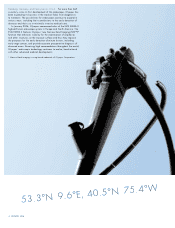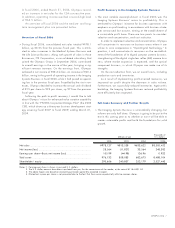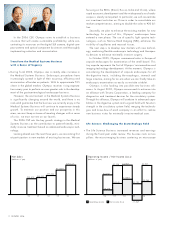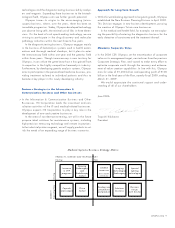Olympus 2006 Annual Report Download - page 15
Download and view the complete annual report
Please find page 15 of the 2006 Olympus annual report below. You can navigate through the pages in the report by either clicking on the pages listed below, or by using the keyword search tool below to find specific information within the annual report.
8.
Please tell us about mid- and long-term objectives
for this business.
> Despite the improvement of revenues in fiscal 2006, we have to
maintain a belt-tightening management posture and a focus on
efficiencies and meeting our sales and inventory targets. The first
step is to comprehend current business conditions and develop
strategies to achieve our goals. I will make every effort to carry
out the three-year reform plan in a steady and effective manner.
Currently, compact digital cameras account for approximately
70% of the business portfolio, and I think this is somewhat unbal-
anced, given the market conditions. Three years from now, in
fiscal 2009, ending March 2009, we will cut this percentage to
about 60% and boost the digital SLR camera share to 20%.
On another front, we expect that there is a high growth poten-
tial for the sales of optical devices to enterprises. On the back of
our strong reputation for the superior performance of our digital
camera lens barrels, we made a full-scale entry into the external
sales business of these barrels and saw a steady increase in sales
during fiscal 2006. Having established a solid foundation and
position in the external sales of compact digital camera lens bar-
rels, we will proceed to the next phase to fortify external sales of
optical devices in new fields.
> With the implementation of such business structural reform, we are
striving for net sales of ¥300 billion and operating profit of ¥12
billion and also an operating profit ratio of 4% in the fiscal year
ending March 31, 2009.
We aim to become a business enterprise that can create sus-
tainable revenues and win the solid, ongoing confidence of all
stakeholders. In order to do so, we will undertake strong compa-
nywide endeavors. Please keep an eye on our business operations
for this fiscal year.
We appreciate your continued support and understanding.
Masaharu Okubo
President, Olympus Imaging Corp.
6.
How has the market reacted to new products released
in fiscal 2006?
> Compact digital cameras gained popularity due to the newμ700,
μ710 and μ720SW (Stylus 700, Stylus 710 and Stylus 720SW
in the U.S.) released in the second half of fiscal 2006, ended
March 31, 2006. This μ/Stylus series has been in great demand
in the market because of its distinctive design and advanced func-
tions. We also saw a steady sales increase in the digital SLR
lineup, as the new E-500 (EVOLT E-500 in the U.S.) digital SLR
camera received high valuation for its light weight, while the
E-330 (EVOLT E-330 in the U.S.) garnered praise for brand-new
features such as the Live View function. We plan to further accel-
erate the digital SLR camera business, aiming to release several
new products annually.
7.
Please tell us about your strategies regarding the future
enhancement of digital SLR cameras.
> Our basic philosophy towards digital SLR cameras is to respond
to market needs with our ingenious technology and to satisfy
people’s aspirations for “keeping precious memories beautiful.”
Our desire is to give more people satisfaction in taking pictures
exactly as they want, since there are still few people who can
experience such pleasure. This has been the constant longing of
picture takers ever since the era of the film SLR camera. Today,
this is possible due to the superiority of the Four Thirds System, the
new standard purely designed for the next generation digital SLR
camera system. The Four Thirds System has the ability to realize
optimum balance among all key elements, including image qual-
ity, product cost, and overall size. Considering the future progress
of digital technology, we will take maximum advantage of the
capabilities of the Four Thirds System standard, while striving to
achieve unique miniaturization of digital camera technology in
order to cultivate new markets.
4.6
1.7
1.4
2.1 2.0
1.4
01 02 03 04 05 06
Digital Camera Inventor y Turnover
(Months)
OLYM PUS 20 06 13
























